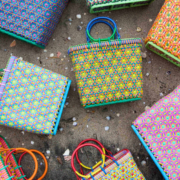Introducing Nicola & Zay Bag’s
The story of ZAY began in the hot historic city of Mandalay, a place that changed my life and lives in my heart. ZAY’s name derives from the Myanmar word for “market”. The local markets are central to life in Myanmar, full of colour and where most people take their Zay Khin (market baskets) to fill with tropical fruits and flowers. Inspired by this city, known to locals as, “market city,” as every family seems to have a small shop perched in front of their house.
It was here that Nicola’s love of beautiful handwoven bags started to grow, they were so practical for lugging watermelons, onions and potatoes home from the market. Perfect to throw in a couple of water bottles, snacks and towels to go swimming. To carry books and art resources to the Buddhist nuns she taught English.
Carrying her basket would make her so happy. It was obvious they were handmade and she wondered who made them and how they were made, so she started asking friends about them. Eventually Nicola found a lady that weaves them across the road. At her house she showed Nicola how she used a frame to weave around, and her stockpile of used pallet tape. Nicola appreciated these baskets more and became a bit obsessed. They worked together to create some baskets that would work well in New Zealand.
The day New Zealand announced that it would go one use bag free by July 2019, Zay was created. Inspired by the environmental movement in New Zealand and around the world of eliminating one use plastic bags. Nicola knew they were a perfect alternative as they can be reused hundreds of times.
Through relentless searching She found the most skilled weavers from the traditional back streets in Mandalay to remote farming villages that don’t appear on google maps. All of our bags are made from families who for generations have past the skills down from mother to daughter.
Living in Myanmar Nicola was able to build trust with the weavers and focus on designs, quality and transportation needs. Logistics in Myanmar face huge difficulties but with wonderful people on the ground and the desire of the weavers to make this happen, they continue to overcome them.
The outcome is that they can bring these portable pieces of artistry, which are designed to be used every day.



